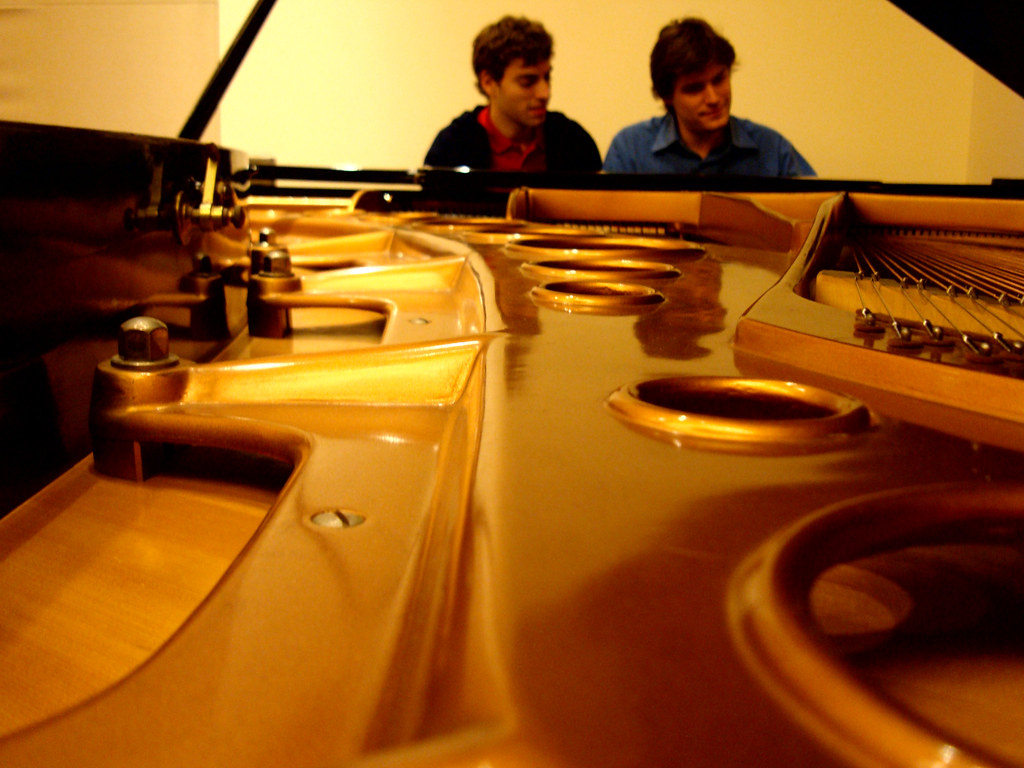
Ambisonics: a way of encoding and decoding audio information using vector math. While the current system of "surround sound" uses simple pan pots to give the illusion of position inside a sound field, ambisonics makes use of the way sound waves interact (reflection, refraction, interference) within an acoustic space. As a result, Ambi-B formats need to be calibrated for each individual speaker setup. Calibration includes identifying where the speakers are placed in the room; their angle and distance from one another.
Applied: we created an interactive sound field where users, by turning their heads, could focus on different audio point sources in a virtual sound field. The input to our program is a magnetometer on top of the person's head that tracks which direction they're is facing. Stephen demonstrates:
Preparing for BOOM included a lot of long nights, one of which I'd like to share with you now:
8:30pm - I show up at the lab. Spencer is already working. Stephen shows up 15 minutes later.
9:23pm - Spencer shows us Unpimp ze Auto
9:31pm - Spencer shows us the robot chicken Gummi Bear. We are clearly getting a lot of work done
11:15pm - Graeme and Kat join us
12:08am - Graeme points out that he's been video taped while teaching CS211, and the video made it to the front page of cornell.edu . We laugh for 10 minutes about how functions return "birthday presents".
12:40am - Spencer finds a semi functional retro game device in the lab. We take 7 minutes from work to play the math game "less than or greater than". In the process, the old batteries leak out onto Spencer's hand causing a battery burn casualty.
2:30am - most of the team calls it quits for the night, except me and Spencer. We're convinced we can solve the problem before we go to bed
3:30am - we contemplate the idea of going to bed out loud.
7:00am -bed
29.2.08
Applied Ambisonics
-
esbie
,
12:48 PM
0
comments
![]()
Labels: Ambisonics, Programming
23.2.08
Procedural Video Games
Things have been quiet on my end as I ramp up for next week. At the moment I'm reaching you from the Western timezone: I've been in San Jose for the past couple days attending Google's Workshop for Women (more posts to follow on that). Among other things, I've been asked to give a presentation at Cornell's annual technology conference, Bits On Our Mind, or BOOM. I'll be giving a talk on Procedural Generation and how it relates specifically to video games and the new video game Spore, slated to be released in the US September 2008.
Since the talk will be given to ~100 high school students, I've left out all the intricate algorithms in favor of video game trailers. Here are some of the videos I'll be using:
Procedural Generation is a way of creating objects in video games using algorithms. This is especially useful if you want to create lots and lots of objects. These objects (such as buildings or trees) might take forever for humans to make one by one, but an algorithm can create thousands of these objects with minimal effort. The Game Beta .kkreiger is a quintessential example of procedural generation in action. Since the level, textures, and enemies are all created procedurally, the game in total is a mere 96kb. That means it could fit on a floppy disk. Here's a download link to try the game out if you'd like to see it in action.
-
esbie
,
4:45 PM
2
comments
![]()
Labels: Procedural Generation, Programming, Video Games
12.2.08
Sunrise On Saturn
This semester I'm the proud owner of 23 academic credits, 3 of which belong to a class called "Computers in Music Performance". The Cornell Electroacoustic Music Center website comes complete with blog, so I'll be making some music related posts there as well (perhaps with some overlap here). Fresh off the composing press, here is the result of my first assignment in the class.
I made the entire piece in Reason with a single recording of a marimba roll, and a piano midi plugin. If you listen carefully there's actually a third voice, made with the marimba roll transposed 2 octaves, lfo at a high frequency, and a reverb patch.
(Sunrise On Saturn Link)
-
esbie
,
6:33 AM
2
comments
![]()
Labels: composition, music
2.2.08
The Bösendorfer Piano
 This monster piano was just purchased by Professor Bailey for use by the Music Department. It's a Bösendorfer Imperial Grand Piano made in Austria, complete with 97 keys for a total of 8 octaves (a normal Steinway Grand Piano has only 88 keys). The extra bass keys are in fact hidden under a wooden flap (which seems a little silly) but are remarkably the clearest bass notes I've ever heard on a piano.
This monster piano was just purchased by Professor Bailey for use by the Music Department. It's a Bösendorfer Imperial Grand Piano made in Austria, complete with 97 keys for a total of 8 octaves (a normal Steinway Grand Piano has only 88 keys). The extra bass keys are in fact hidden under a wooden flap (which seems a little silly) but are remarkably the clearest bass notes I've ever heard on a piano.
A quick history lesson on pianos
Early harps were quickly transformed into the harpsichord, it's mechanical cousin. To play it, the musician presses a key, and that key is part of a mechanism with a quill attached on the end. The quill then plucks the string inside the harpsichord. By increasing the tension of the strings and changing from quills to tiny hammers, the fortepiano (meaning literally "the loudsoft" because you now could play either quietly or loudly) was born. Eventually the name was shortened to piano, and it became the instrument that we know today. Here's a closer look at the four thick bass strings you'll probably never see on another piano. You can also see here and in the photo above that this set of strings crosses diagonally over a set of strings just underneath them. This is because the bass notes need much longer and thicker strings, and placing them diagonally across the piano body saves space. The picture below shows the metal casing for the piano's soundboard. The strings of the piano create the notes, but it's the soundboard that acts as a resonator to project that sound. That's why there are those funky holes built into the soundboard's casing: to help the sound travel (that's also why you lift the lid of the piano).
Here's a closer look at the four thick bass strings you'll probably never see on another piano. You can also see here and in the photo above that this set of strings crosses diagonally over a set of strings just underneath them. This is because the bass notes need much longer and thicker strings, and placing them diagonally across the piano body saves space. The picture below shows the metal casing for the piano's soundboard. The strings of the piano create the notes, but it's the soundboard that acts as a resonator to project that sound. That's why there are those funky holes built into the soundboard's casing: to help the sound travel (that's also why you lift the lid of the piano).
I even have a short audio clip of Spencer playing this Bösendorfer. The low notes are just incredible.
Piano Clip
-
esbie
,
8:13 PM
4
comments
![]()
NightLight Sequence
 I've been quite taken by the "solarize" filter by Nikon. So much so in fact that my first ever sequence as a photographer is taking the solarize filter and running with it. These combination photographs/digital art include "Not what I expected" and "Crystal Blue" whose source files were taken in Costa Rica. The newest additions to the sequence were taken on plane rides to and from Seattle, Washington. Visit my Flickr account to see the rest of them.
I've been quite taken by the "solarize" filter by Nikon. So much so in fact that my first ever sequence as a photographer is taking the solarize filter and running with it. These combination photographs/digital art include "Not what I expected" and "Crystal Blue" whose source files were taken in Costa Rica. The newest additions to the sequence were taken on plane rides to and from Seattle, Washington. Visit my Flickr account to see the rest of them.
-
esbie
,
7:39 PM
1 comments
![]()
Labels: art, photography
How I Got Here, Musically Speaking
I did some digging around this week and found a bunch of my older compositions, each with its own story. Here they are in chronological order.
PI, the oldest piece, was created with the intent of 3 or 4 later movements. Although orchestrated here for two pianos, it's entirely possibly to play on 2 or 3 marimbas instead.
PI link
the next, JM, is actually an orchestration of the opening theme for Final Fantasy: Crystal Chronicles. The piece was made as an accompaniment for me as part of my talent for the New Mexico Junior Miss pageant. Although I regrettably don't have a recording of my singing along, you can look up the lyrics and sing them yourself! JM contains a 4 measure intro, the first verse, an instrumental, and the second-to-last chorus. Here's a snipet of the original piece "Kaze No Ne" (Sound of the Wind) for comparison.
JM link
DOS, made in my senior year of high school, was made at the request of a friend and turned out to be one of my best techno tracks so far.
DOS link
The most recent of this collection, ReasonStudy, was made last semester. It was my first attempt at using Reason during my lessons (and it shows).
ReasonStudy link
Hopefully my work is showing some sort of growth, although what kind I can't quite figure out.
-
esbie
,
5:54 PM
2
comments
![]()
Labels: composition, music, Video Games


